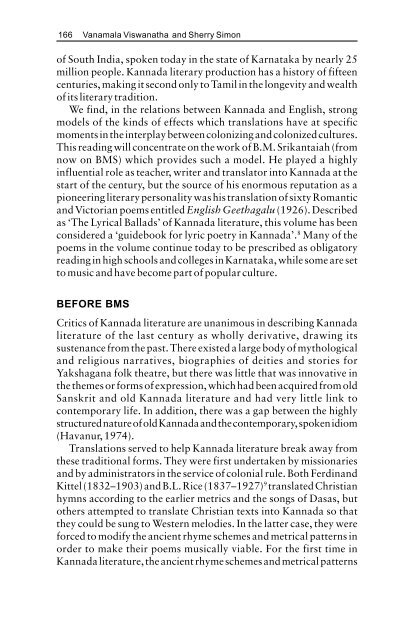post-colonial_translation
post-colonial_translation
post-colonial_translation
Create successful ePaper yourself
Turn your PDF publications into a flip-book with our unique Google optimized e-Paper software.
166<br />
Vanamala Viswanatha and Sherry Simon<br />
of South India, spoken today in the state of Karnataka by nearly 25<br />
million people. Kannada literary production has a history of fifteen<br />
centuries, making it second only to Tamil in the longevity and wealth<br />
of its literary tradition.<br />
We find, in the relations between Kannada and English, strong<br />
models of the kinds of effects which <strong>translation</strong>s have at specific<br />
moments in the interplay between colonizing and colonized cultures.<br />
This reading will concentrate on the work of B.M. Srikantaiah (from<br />
now on BMS) which provides such a model. He played a highly<br />
influential role as teacher, writer and translator into Kannada at the<br />
start of the century, but the source of his enormous reputation as a<br />
pioneering literary personality was his <strong>translation</strong> of sixty Romantic<br />
and Victorian poems entitled English Geethagalu (1926). Described<br />
as ‘The Lyrical Ballads’ of Kannada literature, this volume has been<br />
considered a ‘guidebook for lyric poetry in Kannada’. 8 Many of the<br />
poems in the volume continue today to be prescribed as obligatory<br />
reading in high schools and colleges in Karnataka, while some are set<br />
to music and have become part of popular culture.<br />
BEFORE BMS<br />
Critics of Kannada literature are unanimous in describing Kannada<br />
literature of the last century as wholly derivative, drawing its<br />
sustenance from the past. There existed a large body of mythological<br />
and religious narratives, biographies of deities and stories for<br />
Yakshagana folk theatre, but there was little that was innovative in<br />
the themes or forms of expression, which had been acquired from old<br />
Sanskrit and old Kannada literature and had very little link to<br />
contemporary life. In addition, there was a gap between the highly<br />
structured nature of old Kannada and the contemporary, spoken idiom<br />
(Havanur, 1974).<br />
Translations served to help Kannada literature break away from<br />
these traditional forms. They were first undertaken by missionaries<br />
and by administrators in the service of <strong>colonial</strong> rule. Both Ferdinand<br />
Kittel (1832–1903) and B.L. Rice (1837–1927) 9 translated Christian<br />
hymns according to the earlier metrics and the songs of Dasas, but<br />
others attempted to translate Christian texts into Kannada so that<br />
they could be sung to Western melodies. In the latter case, they were<br />
forced to modify the ancient rhyme schemes and metrical patterns in<br />
order to make their poems musically viable. For the first time in<br />
Kannada literature, the ancient rhyme schemes and metrical patterns


